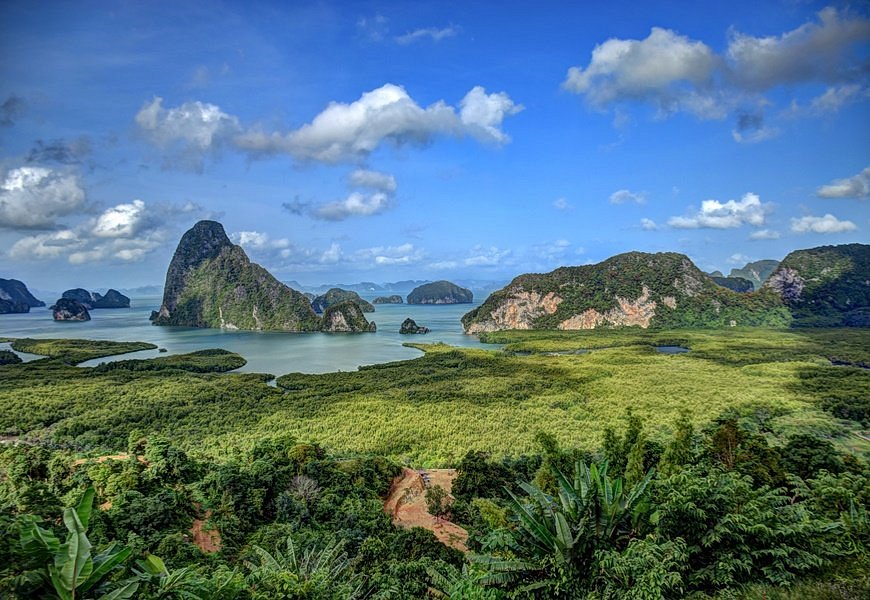Samet Nangshe Viewpoint: Where Nature Paints the Sky
Nestled in Thailand’s Phang Nga Province, Samet Nangshe Viewpoint offers one of Southeast Asia’s most breathtaking panoramas. Rising above mangrove forests and emerald waters, this hidden gem overlooks a labyrinth of limestone karsts that pierce the horizon like ancient sentinels. While lesser-known than nearby tourist hotspots, Samet Nangshe has become a pilgrimage site for photographers, adventurers, and seekers of serenity. Its magic lies not just in the view but in the journey—a predawn hike rewarded with sunrises that set the sky ablaze, casting golden light over Phang Nga Bay. This article explores the viewpoint’s natural grandeur, cultural whispers, and the delicate balance between preservation and exploration. Prepare to discover why this spot is a testament to Earth’s raw, unscripted beauty.
A Vista of Untamed Beauty: The Landscape of Samet Nangshe
Samet Nangshe’s allure begins with its geology. The viewpoint sits atop a 300-meter hill, offering a 180-degree vista of Phang Nga Bay’s jagged limestone formations, formed over 250 million years. Below, mangrove forests—a UNESCO-recognized ecosystem—thrive in tidal zones, acting as natural carbon sinks. At dawn, the bay transforms: mist clings to karsts, tides reveal hidden lagoons, and the first light paints the water in hues of amber and sapphire. This landscape isn’t static; it’s a living canvas shaped by monsoons, tides, and tectonic whispers. The area’s biodiversity includes rare birds like the Brahminy kite and marine life such as dugongs, making it a silent sanctuary for ecological harmony.
A Journey to Dawn: The Pilgrimage of Early Risers
Visiting Samet Nangshe demands commitment. Most travelers arrive by 5 AM, navigating a steep 20-minute climb aided by rope railings and flashlight beams. The effort is a ritual—a shared silence among strangers awaiting the sunrise. Local guides often share stories of the bay’s moods: how fog blankets the karsts in rainy seasons or how summer stars mirror the bay’s bioluminescent plankton. The summit’s rustic wooden platform becomes a communal space where travelers from Tokyo to Toronto trade awe-struck glances. This predawn pilgrimage isn’t just about the view; it’s a reminder that nature’s grandest spectacles require patience, respect, and a willingness to embrace the unknown.
Whispers of History: Cultural Echoes in the Cliffs
The name Samet Nangshe hints at deeper tales. Locals say it derives from a legendary princess (Nangshe) who once ruled the area, her spirit guarding the bay. Fishermen still lay offerings at small shrines nestled in mangrove roots, seeking protection before venturing into the Andaman Sea. The karsts themselves are cultural artifacts—some hiding caves with prehistoric paintings, others serving as navigational markers for ancient seafarers. Even the viewpoint’s recent popularity ties into Thai values: the land is privately owned but open to the public, reflecting a Buddhist-inspired ethos of sharing nature’s gifts. Here, geography and mythology intertwine, making every rock and wave a chapter in an unwritten epic.
Preserving Paradise: Balancing Tourism and Conservation
As Instagram fuels Samet Nangshe’s fame, sustainability becomes urgent. Unlike overcrowded destinations like Maya Bay, this spot remains pristine—but fragile. Challenges include:
- Waste management: Visitors are urged to carry trash downhill, as no facilities exist atop the viewpoint.
- Erosion control: Foot traffic threatens the trail; community-led bamboo reinforcement projects aim to mitigate damage.
- Cultural preservation: Guides advocate for quiet observation to honor the site’s spiritual significance.
Local NGOs collaborate with villagers to promote eco-tourism, offering homestays that fund conservation. The goal isn’t to restrict access but to cultivate mindful exploration—a model for protecting fragile wonders worldwide.
Samet Nangshe: A Mirror to Humanity’s Relationship with Nature
Samet Nangshe Viewpoint is more than a photo op; it’s a microcosm of humanity’s dance with the natural world. Its cliffs remind us of Earth’s ancient rhythms, while its fragile ecosystem underscores our role as stewards, not conquerors. The predawn climb mirrors life’s journeys—arduous, communal, and infinitely rewarding. As tourism grows, the site’s future hinges on balancing wonder with wisdom. Perhaps its greatest lesson lies in the sunrise itself: a daily rebirth urging us to tread lightly, listen to ancestral whispers, and preserve the quiet magic that still exists, unspoiled, in corners of our planet.
